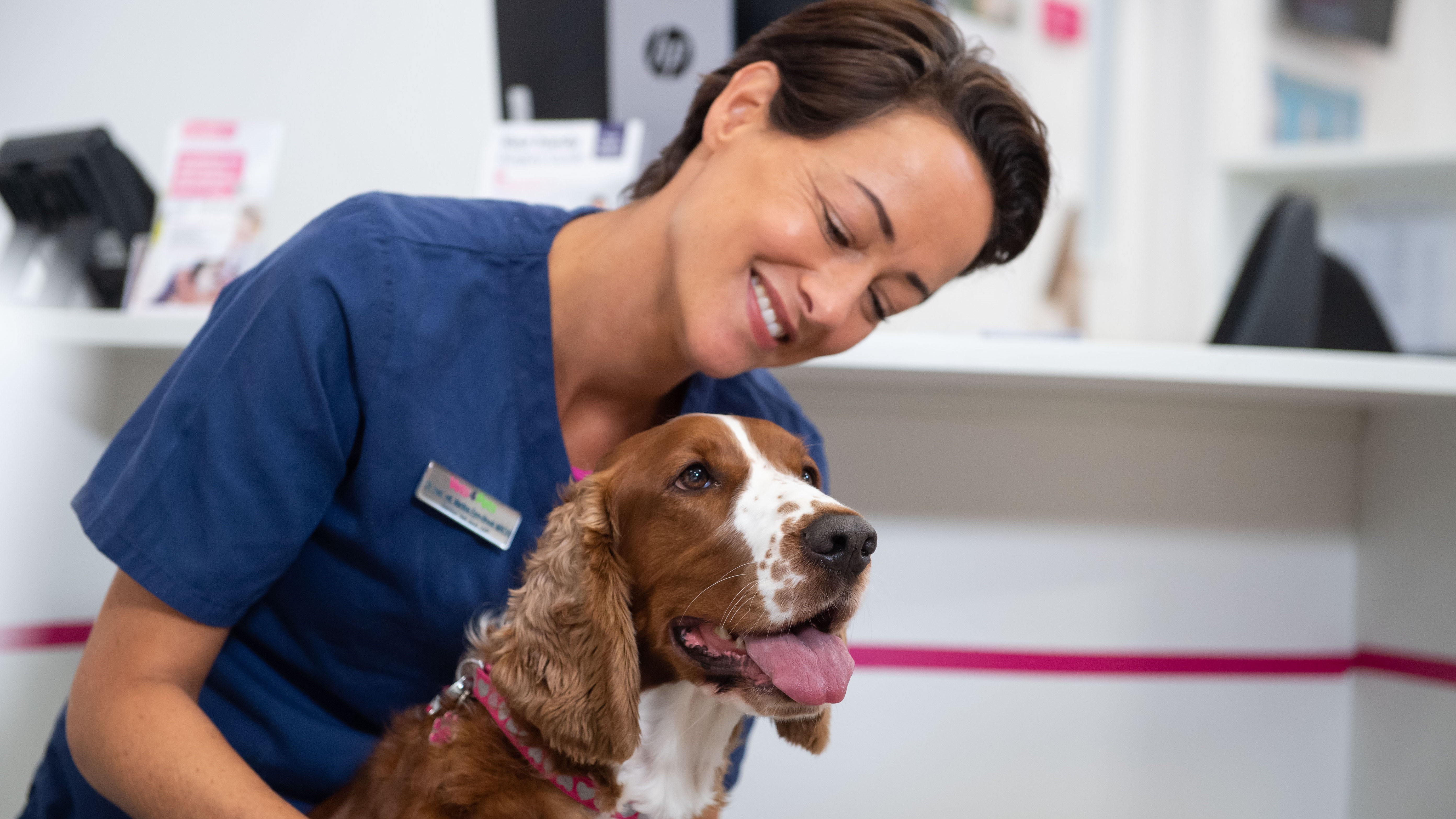
Dog Diabetes Advice & Care
How to handle canine diabetes
It is estimated that 1 out of every 100 dogs that reaches 12 years of age will develop diabetes. Diabetes mellitus, the most common form of diabetes, is caused by a problem with the production of a hormone called insulin. If your dog has been diagnosed by diabetes, this can come as quite a shock, however understanding the disease can help with understanding the required treatments, and you may find this advice helpful.
Management of diabetes in dogs requires daily medication and a strict routine. Although this can seem daunting, your vet and all the team at your local Vets4Pets can help.
Diabetes produces a range of clinical signs in dogs.
The main clinical signs of diabetes include:
- Increased thirst
- Increased urination
- Increased hunger
- Weight loss
- Tiredness
These signs can also be associated with other diseases, so it is important for your vet to do some tests to check and see if your dog has diabetes or another condition.
Diabetic dogs may also go on to develop cataracts in their eyes, suffer fits and collapses, and have a range of chronic health issues.
Clinical signs are not enough to diagnose a dog with diabetes. This is because these signs can be seen with a number of diseases. This means your vet will need to conduct tests to confirm diabetes before recommending any treatment. This is a requirement, as giving insulin to a non-diabetic dog could be fatal.
Tests for diabetes:
- Urine test. This looks for sugar in the urine. Normally all sugar is caught by the kidneys and kept in the body, but in diabetes the sugar is so high some escapes and can be measured in urine. In the olden days tasting urine to see if it was sweet was a test for diabetes, but thankfully urine testing methods have moved on since then!
- Screening blood test. This measures sugar levels in the blood directly. Screening blood tests can also look for other markers of illness, so your vet can get a good idea of your pet's general health as well as looking for other diseases.
- Fructosamine. This is a specific blood test that is used in dogs that have already been diagnosed with diabetes. It measures the average blood sugar content over a period of 2-3 weeks.
Routine
This the key to success when caring for your diabetic dog. To achieve the best control possible you will need to manage their insulin, exercise and diet. Your Vets4Pets team will do all they can to help you achieve this.
Insulin
As your dog cannot produce their own insulin giving insulin via injection is the only way their blood sugar levels can be managed. Insulin injections are usually given every 12 hours, immediately after meals. Your dog’s starting insulin dose will be based on their body weight. Your vet will then monitor your dog’s response to the insulin, making adjustments to the dose until the current optimal dose has been determined.
This process can take weeks or months, and your dog’s ideal dose may change over time so it’s important to keep having regular check-ups with your vet. Getting the dose right is critical – a too high dose can push your dog’s blood sugar too low, which is very dangerous. Many people find the idea of injecting their dog scary at first. Your vet will spend time with you showing you how to inject your dog – the needle is very fine and most dogs don’t react at all!
Diet
Dogs should be fed the same diet twice a day, and these should be their only meals. A high fibre diet will help to slow glucose absorption, as well as helping your dog feel full through the day, so ask your vet for recommendations.
It’s important not to give your dog any extra food or treats through the day, as this will raise their blood sugar and won’t be paired with an insulin injection. If your dog does eat any extra food accidentally call your vet for advice as soon as possible. Don’t give extra insulin unless instructed to do so. If your dog refuses their food or vomits you should also speak to your vet as soon as possible.
Do not give your dog their insulin dose if they haven’t had their full meal, unless instructed to do so.
Exercise
Exercise is important for pets with diabetes. It can help avoid high blood sugar levels and may improve insulin absorption. That being said, too much exercise can cause glucose levels to drop too low, resulting in hypoglycaemia. Aim for steady, moderate-intensity activities, and keep their activity pattern stable. Doing short walks in the park in the week and a ten-mile hike at the weekend isn’t appropriate for a diabetic dog!
Monitoring of diabetic dogs is done by looking at their blood sugar levels, as well as their clinical signs.
Blood sugar
Blood sugar levels are measured in two ways:
- A glucometer. This measures the blood glucose (sugar) in a drop of blood and is a snapshot of the blood glucose level at that moment. This is good for doing glucose curves, where blood sugar levels are measured every one to two hours through the day. This shows the peaks and troughs of blood sugar and how levels respond to both eating food and insulin injections. Doing these at home, if you feel confident to do so, will also help you monitor your dog's diabetes as you learn what is normal for them.
- Fructosamine. This is measured in a small sample of blood to give an average blood sugar level over the previous 2-3 weeks. This is a good measure of how controlled blood sugar levels have been.
Both of these tests are useful when assessing a diabetic dog.
Hypoglycaemia
When a pet’s blood glucose levels fall too low this is called hypoglycaemia, a dangerous complication of diabetes.
Hypoglycaemia can happen when your pet has had too much insulin, or if they do not eat after having received their normal insulin dose.
If your dog’s blood sugar falls too low they may show signs such as:
- Tiredness
- Stumbling
- Drinking and urinating more than usual
- Seizures
- Unconsciousness
Keeping high sugar items around, such as glucose powers/gels, is recommended for emergencies as they can be rubbed on the gums and absorbed.
If you think your dog has low blood sugar this is an emergency and you should contact your vet immediately.
Insulin FAQs
Insulin is produced by the pancreas and signals cells to absorb glucose (sugar) from blood. This glucose provides energy for the cells. Insulin is produced whenever blood sugar levels start to rise, normally after meals. This helps keeps your dog’s blood sugar levels stable as the insulin moves the sugar from the blood into the cells.
In almost all diabetic dogs insulin production is decreased or absent. This is the same as Type 1 diabetes in humans. Very rarely cells are ‘resistant’ to the effects of insulin, a form similar to Type 2 diabetes, but this is much more commonly seen in cats.
Dogs who cannot produce enough insulin cannot control their blood sugar levels. The levels of sugar in the blood rise to dangerous levels (called hyperglycaemia). Chronically elevated levels of sugar increase the risk of other health problems, and also lead to visible clinical signs and irreversible changes such as cataract formation. This disease is incurable and can only be managed, however dogs who are closely managed and respond well to treatment can live very happy lives.
What should I do if I'm worried?
Worries about the implications of a dog with diabetes, including cost, commitment to routine and emotional strain are all normal.
Your vet and nursing team are there to support you, as well as provide veterinary care for your dog.
If you have any questions or concerns about your dog’s diabetes and managing it at home, please speak to your vet or nurse who can help with advice, information and support.
If you are worried about your diabetic dog and feel they are behaving abnormally always contact your practice immediately. They can give you advice and see your dog if they recommend it.
Health Plans to keep your dog healthy
At Vets4Pets we offer a range of Health Plans that make essential routine treatments more affordable. You'll save money on things like annual vaccinations, flea and worm treatment and routine health check-ups.

Dog Advice
Read more of our expert dog advice to keep your dog happy and healthy.
